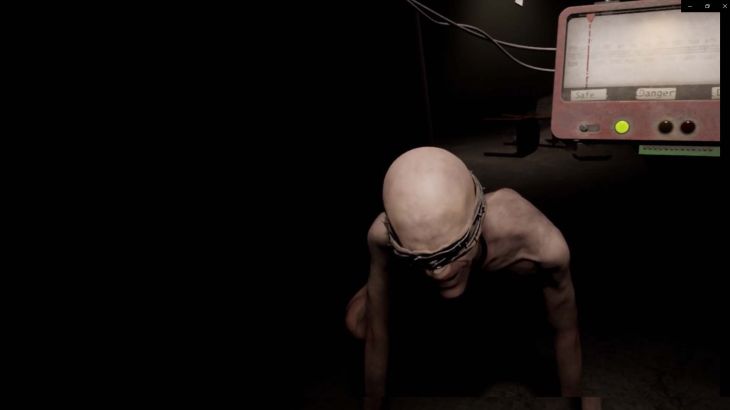With the VR headset in place and a pulse oximeter attached to your finger, you are ready to delve into the virtual world that Daniel-Watanabe and the team at Ninja Theory have created.
The training takes place in two stages. To begin with, you find yourself in a rowing boat, drifting along an estuary. A voice guides you to breathe in for five seconds, hold for five seconds, and breathe out for five seconds, repeating over five minutes while a soothing, New Age soundtrack lulls you into a feeling of serenity. The technique would not feel out of place in a mindfulness class or on a relaxation app.
You are very unlikely to find the next step in your mindfulness class, however.
“The second part is, we put people in a very scary stressful situation and we ask them to try and remember that breathing technique,” explains Daniel-Watanabe. “It’s teaching you this regulation mechanism and then asking you to apply it in a very stressful situation.”
And when she says stressful, she is not kidding.
“You’re here in a dungeon with a monster wandering around, but the monster can't see, it can only hear you.”
This piece of good news is short-lived.
“The only thing it can hear is your heartbeat. There's a little dial in the top corner of [your vision] that has a green and amber or red light, and the closer you keep your heart rate to the baseline – that's what it was when you were on the boat – the light will stay green. But if it increases by however many beats per minute, it'll turn to amber, then if it increases again, it'll go red and that shows how much danger you're in from the monster.”
Having played such classic PlayStation horror games as Resident Evil IV, I’m not unfamiliar with being terrified by monsters, but in that instance (a) I was not playing in virtual reality, where your sound and vision are completely immersed in the game; and (b) I could run away every time I heard the chanting of rabid monks approaching.
What's that lurking in the shadows? (Credit: Ninja Theory)
What's that lurking in the darkness? (Credit: Ninja Theory)
Here, however, as a mutilated creature crawls up so close that you can almost feel its breath on your face, your only defence is to remain calm. This is not easy: at one point, I make the mistake of looking to my right and realise that in the room next to me someone is also strapped to the chair and (Spoilers!) theirs is not a happy ending.
You are not alone (Credit: Ninja Theory)
You are not alone (Credit: Ninja Theory)
Fortunately, I do live to tell the tale. In fact, despite feeling at times that I could hear my own heartbeat, I manage to do surprisingly well. A couple of times, the light trips briefly to amber, but according to Daniel-Watanabe my heart rate only ever increases by around ten beats per minute.
So far, around two dozen people have taken part in the experiment, with Daniel-Watanabe aiming to test up to 100 people. As well as the virtual reality experience, each participant completes a detailed questionnaire that will allow her to see where there are particular traits or experiences that make a person better able to cope. Are people who are more anxious, worse at this task, or do they perform better, for example? Are horror fans or hard-core gamers less likely to be terrified and therefore remain calmer?
Using virtual reality to help people overcome their fears is not new. It has been used previously to help people overcome phobias, everything from a fear of spiders to public speaking. It is now even being offered in some NHS clinics.
But the partnership with Ninja Theory potentially takes Daniel-Watanabe’s work to another level.
First off is the quality of the experience. Researchers may be experts in their field, but limited resources mean that the virtual reality environments they employ tend to be relatively simple and unrealistic.
“Everything is done by academics, which is how academia kind of works, but often means that you get a slightly less optimal thing than you would if you had someone who specialised [in VR technology].”
The graphics in Daniel-Watanabe’s experiment may not be quite as sophisticated as those in Hellblade – which were stunningly beautiful – but they are not far off.
Second is the application.
“With mindfulness and a lot of these meditative apps, there's no incentives, there's no drive. You have to be self-motivated enough to want to do them. Gaming has that intrinsic motivation built into it.”
In other words, by building these techniques into a game, people will want to take part. But even if her work doesn’t lead to the full ‘gamification’ of mindfulness counselling, as she says: “[We will have] created a cool breathing exercise that you can do in VR."
In the future, she hopes that games that employ this approach – whether using VR or a tablet – might be rolled out to clinics, GP surgeries or pre-surgery, where people get very anxious, so that people can have fun while learning valuable relaxing exercises.
While her work is still at a very early stage, she has received some very encouraging feedback. “One of our [participants] sent me some feedback saying that she had had a really rough weekend and she was getting very anxious, and she remembered the breathing techniques that she learned on the boat. She tried to use them again and was able to calm herself down, which was kind of unexpected because we weren't expecting this to be actually useful to anyone [yet].”
Daniel-Watanabe has now put around fifty volunteers through her trial and has begun analysing the data to see if it has been successful. Her next step is to expand the trial, tweaking the training. For this, she will be looking to recruit subjects from different backgrounds and experiences, not just those who are familiar with the worlds of gaming and VR.
They will just have to be ready for the fright of their lives.







